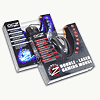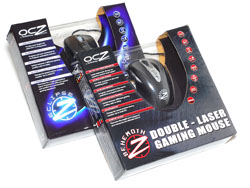 5
5
OCZ Eclipse & Behemoth Laser Gaming Mice Review
(5 Comments) »Introduction

OCZ is mostly known for their quality PSU and memory products such as SSDs, and performance memory kits. Today we will be taking a look at the newest addition to their gaming peripheral lineup, namely the OCZ Behemoth and Eclipse gaming mice. Both of these mice feature what OCZ calls "Double-Laser" sensors which I will get back to further on in the review. The Behemoth has a DPI rating of a massive 3200 DPI whereas the Eclipse manages "only" 2400 DPI. With the Eclipse priced at 24.99 € and the Behemoth at 26.99 € both mice reside in the budget gaming mice price tier, along with such mice as the Razer Salmosa, Microsoft IntelliMouse Explorer 3.0, Logitech MX518.
The Package
The two mice ship in almost identical boxes, both very colorful.
The bundle is not exactly huge with these mice. You get with the mouse a set of weigths, a manual, and a driver disc. You do not get any spare sets of mouse feet with these two OCZ mice and that can pose a problem especially with the Eclipse, since it has some uniquely shaped feet. The Behemoth's feet are almost identical to the size and shape of the feet featured on Logitech MX-series mice, so getting replacements will not be a problem here. Compared to the price of the units the bundle is sort of what you would expect.
Closer Examination
Shape wise these two mice have very little in common. The Behemoth mouse has a really wide body with a lot of bends and groves that are meant to guide your hands to a comfortable grip. The Eclipse is very different in that regard since it has an almost symmetric shade. This also means that it can be used by left handed people although they will lack thumb buttons in that case. The scrollwheels are somewhat similar in the amount of tactile feedback, but the Eclipse's is translucent and is used as an indicator as to which profile is loaded.
The underside of the Behemoth mouse has a small door that you can open up to insert the weigths. Both mice feature a profile button located underneath which is used to swap profiles on-the-fly. The location is some what troublesome because you need to flip the mouse on its back in order to access it.
The trim weight system resides at two very different places in these two mice. The Eclipse has a removable palm plate that allows you to access the weights whereas the Behemoth has a door underneath. The fact that the weights are placed much higher in the body of the Eclipse is not a good thing because it gives the mouse a higher center of gravity making it feel a wee bit less secure to maneuver around.
From this side you can clearly see the forced ergonomics of the Behemoth contra the open design of the Eclipse.
The thumbs button arrangement is a bit better on the Behemoth because you have two large buttons compared to the two slim ones on the Eclipse. Position wise the Behemoth's are likewise more ideal.
Cable wise the two mice are very different. The Behemoth features a sleeved cable where the Eclipse makes due with a normal cable. The Behemoth's cabe is slightly stiffer, but it can also be routed out through the side of the mouse which means that this might not be quite as big a problem.
In comparison to the Razer DeathAdder and the Microsoft IntelliMouse Explorer 3.0 the Behemoth is almost the same size and shape, however, given the nature of its design the Behemoth has a tendency not to be quite as comfortable as its two similarly designed competitors.
The Eclipse looks a bit like the old Diamondback mouse from Razer, although it has a wider body with a few more trim pieces. The design allows for left hand users to use it as well, but they will lack the comfort of thumb buttons.
Our Patreon Silver Supporters can read articles in single-page format.
Aug 1st, 2025 17:00 CDT
change timezone
Latest GPU Drivers
New Forum Posts
- 3DMARK "LEGENDARY" (358)
- Samsung 870 EVO - Beware, certain batches prone to failure! (1303)
- Z790, affect of high performance DDR5? (1)
- Free Games Thread (4826)
- The Official Thermal Interface Material thread (1806)
- AAF Optimus Modded Driver For Windows 10 & Windows 11 - Only for Realtek HDAUDIO Chips (591)
- Question about Intel Optane SSDs (89)
- AMD Radeon 6900 XT Limited Black Edition Bios Problems - Boost Problems (9)
- Have you got pie today? (16818)
- WCG Daily Numbers (12955)
Popular Reviews
- MSI Claw 8 AI+ A2VM Review
- Lenovo Legion 5i (15IRX10) Review - Feature-Rich and Wallet Friendly
- ASUS ROG Crosshair X870E Apex Review
- Herman Miller Logitech G Embody Review - No Pain, No Gain
- Orbital Pathfinder Review
- Montech X5 Review
- Upcoming Hardware Launches 2025 (Updated May 2025)
- Lian Li O11 Dynamic Mini V2 Review
- Noctua NF-A12x25 G2 PWM Fan Review
- AMD Ryzen 7 9800X3D Review - The Best Gaming Processor
TPU on YouTube
Controversial News Posts
- AMD's Upcoming UDNA / RDNA 5 GPU Could Feature 96 CUs and 384-bit Memory Bus (137)
- AMD Radeon RX 9070 XT Gains 9% Performance at 1440p with Latest Driver, Beats RTX 5070 Ti (131)
- Intel "Nova Lake-S" Core Ultra 3, Ultra 5, Ultra 7, and Ultra 9 Core Configurations Surface (110)
- DDR6 Memory Arrives in 2027 with 8,800-17,600 MT/s Speeds (102)
- NVIDIA to Debut GeForce RTX 50-series SUPER GPUs by Christmas (101)
- AMD Sampling Next-Gen Ryzen Desktop "Medusa Ridge," Sees Incremental IPC Upgrade, New cIOD (97)
- Intel CEO Confirms SMT To Return to Future CPUs (95)
- NVIDIA Becomes First Company Ever to Hit $4 Trillion Market-Cap (94)
















